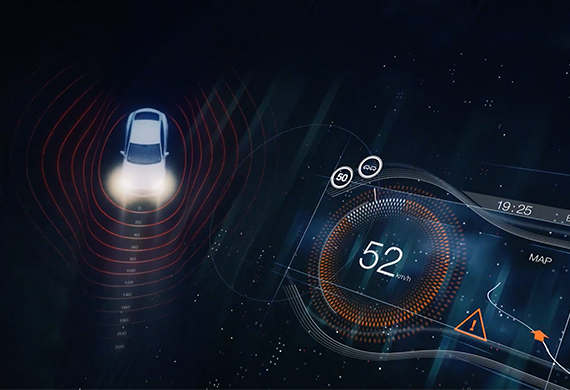Car headlights will be able to do more in the future than simply illuminate the road ahead. Digitalization, sensors, and cloud computing will open up completely new functions <span style="font-size: 16px;">–</span> such as light that can see around corners.
The magic word right now in vehicle front lighting is “dynamic.” New generations of headlamps will dynamically adapt to suit the current traffic situation, ensuring for example that oncoming drivers are not glared or that pedestrians are illuminated more clearly. The light distribution will be directly adapted by camera systems and sensors constantly scanning the surroundings of the vehicle and controlling high-resolution light units, such as matrix headlamps and DMD systems.
On the road
In the case of matrix light, several individually controllable LEDs are combined into a matrix system with common optics, with the LEDs capable of being individually controlled “pixel by pixel.” This enables specific areas of the road to be precisely illuminated. Even greater resolution can be achieved with a digital micro-mirror device (DMD). “Operating in much the same way as a projector, systems with more than one million individually adjustable micro-mirrors will be used to adapt the light distribution pattern with a high level of precision,” explains Dr. Michael Rosenauer, Head of Advanced Development at the OSRAM CONTINENTAL joint venture.
What makes this so special is that the high-resolution mirror projection system will enable not only inch-perfect illumination, but also the projection of warnings in HD quality directly onto the road – and therefore visual communication with other road users. For example, an arrow could be projected on the road to signal that the car is about to turn, or a warning sign to indicate an obstacle on the road. “For the next stage in mobility, namely autonomous driving, every road user must be aware of what everyone else and the autonomous vehicle is doing. We have the technologies and products to communicate this information in the best possible way: with light,” says Rosenauer.
Another prerequisite for smart lighting solutions is a high-definition light control unit for individually addressing the matrix LEDs or the micro-mirrors on the DMD chip. “The joint venture between OSRAM and Continental, which began in July, is bringing together the disciplines of lighting, electronic systems, and software algorithms,” adds Rosenauer. “We will then be able to work more efficiently on entirely new functions.” The controller will be linked to the navigation system via the vehicle’s electrical system. This means that additional information on the distance to the destination, roadworks along the way and speed restrictions can be integrated directly in the vehicle’s lighting control system.
The journey has started
Future generations of headlights will even go one step further. They will receive not only dynamic ambient data from the front cameras and sensors on the vehicle, but also data from other road users via the cloud. A mobile radio module installed in the vehicle will enable two-way data exchange. The vehicle will continually send and receive the latest information on the route and current traffic conditions. “The vehicle’s horizon will be extended,” says Rosenauer. “The system will literally be able to see over the next hill and round the next corner.” A software platform such as “eHorizon” from Continental will bring high-precision road maps, sensor information from the vehicle, and other dynamic information together in the cloud and make this information available to all users. The benefits of such an anticipatory lighting system include greater road safety and significant improvements in driving comfort.
